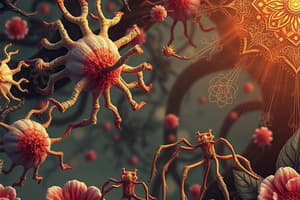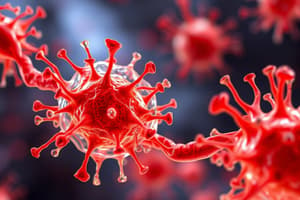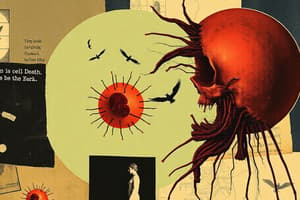Podcast
Questions and Answers
What is the primary role of initiator caspases in the apoptotic pathway?
What is the primary role of initiator caspases in the apoptotic pathway?
- Inhibiting the release of cytochrome-c from mitochondria.
- Directly degrading cellular proteins to induce cell death.
- Binding to the Fas ligand to trigger the extrinsic pathway.
- Activating executioner caspases to initiate the caspase cascade. (correct)
Which structural feature is characteristic of initiator procaspases and facilitates their activation?
Which structural feature is characteristic of initiator procaspases and facilitates their activation?
- An ATP-binding domain that provides energy for proteolytic activity.
- A transmembrane domain that anchors them to the mitochondrial membrane.
- A short prodomain that binds directly to executioner caspases.
- A caspase recruitment domain (CARD) that enables assembly into activation complexes. (correct)
How are initiator procaspases activated in the apoptotic pathway?
How are initiator procaspases activated in the apoptotic pathway?
- Via glycosylation in the endoplasmic reticulum.
- Through conformational changes induced by binding to DNA fragments.
- By proximity-induced dimerization within an adaptor-protein complex. (correct)
- By direct phosphorylation via extracellular kinases.
What is the ultimate outcome of the caspase cascade once it is initiated?
What is the ultimate outcome of the caspase cascade once it is initiated?
Which event triggers the extrinsic pathway of apoptosis?
Which event triggers the extrinsic pathway of apoptosis?
Within the extrinsic apoptosis pathway, what is the role of the death domain found on the cytosolic tail of the Fas receptor?
Within the extrinsic apoptosis pathway, what is the role of the death domain found on the cytosolic tail of the Fas receptor?
What is the composition of the DISC (Death-Inducing Signaling Complex) in the extrinsic apoptosis pathway?
What is the composition of the DISC (Death-Inducing Signaling Complex) in the extrinsic apoptosis pathway?
How do stressed or damaged cells typically initiate the intrinsic pathway of apoptosis?
How do stressed or damaged cells typically initiate the intrinsic pathway of apoptosis?
What role does cytochrome-c play in the intrinsic apoptosis pathway once it is released into the cytosol?
What role does cytochrome-c play in the intrinsic apoptosis pathway once it is released into the cytosol?
How is the apoptosome formed and what is its function in the intrinsic apoptosis pathway?
How is the apoptosome formed and what is its function in the intrinsic apoptosis pathway?
How does the Bcl-2 family of proteins regulate apoptosis?
How does the Bcl-2 family of proteins regulate apoptosis?
What common feature is found in both the extrinsic and intrinsic apoptosis pathways regarding the activation of caspases?
What common feature is found in both the extrinsic and intrinsic apoptosis pathways regarding the activation of caspases?
What is the role of the FADD protein in the extrinsic apoptosis pathway?
What is the role of the FADD protein in the extrinsic apoptosis pathway?
How does the apoptosome activate procaspase-9 in the intrinsic apoptosis pathway?
How does the apoptosome activate procaspase-9 in the intrinsic apoptosis pathway?
What is the critical function of executioner caspases once they are activated?
What is the critical function of executioner caspases once they are activated?
What distinguishes the extrinsic and intrinsic apoptosis pathways in terms of their initial triggers?
What distinguishes the extrinsic and intrinsic apoptosis pathways in terms of their initial triggers?
How do pro-apoptotic Bcl-2 family proteins like Bax and Bak function to promote apoptosis?
How do pro-apoptotic Bcl-2 family proteins like Bax and Bak function to promote apoptosis?
Which of the following accurately describes the sequence of events in the extrinsic apoptosis pathway?
Which of the following accurately describes the sequence of events in the extrinsic apoptosis pathway?
What is a key difference between initiator and executioner caspases regarding their structure and activation mechanism?
What is a key difference between initiator and executioner caspases regarding their structure and activation mechanism?
How does the activation of executioner caspases lead to the dismantling of the cell during apoptosis?
How does the activation of executioner caspases lead to the dismantling of the cell during apoptosis?
Flashcards
Caspases
Caspases
Proteolytic proteins with a cysteine group at the active site, cleaving target proteins at aspartic acid points.
Initiator Caspases
Initiator Caspases
Caspases that initiate the caspase cascade, activating executioner caspases.
Executioner Caspases
Executioner Caspases
Caspases that break down proteins in the nuclear envelope and cytosol, leading to cell death.
Caspase Recruitment Domain (CARD)
Caspase Recruitment Domain (CARD)
Signup and view all the flashcards
Initiator Procaspases
Initiator Procaspases
Signup and view all the flashcards
Executioner Procaspases
Executioner Procaspases
Signup and view all the flashcards
Caspase Cascade
Caspase Cascade
Signup and view all the flashcards
Extrinsic Apoptosis Pathway
Extrinsic Apoptosis Pathway
Signup and view all the flashcards
Fas Receptor
Fas Receptor
Signup and view all the flashcards
FADD (Fas-Associated Death Domain)
FADD (Fas-Associated Death Domain)
Signup and view all the flashcards
DISC (Death-Inducing Signaling Complex)
DISC (Death-Inducing Signaling Complex)
Signup and view all the flashcards
Intrinsic Apoptosis Pathway
Intrinsic Apoptosis Pathway
Signup and view all the flashcards
Cytochrome-c
Cytochrome-c
Signup and view all the flashcards
Anti-Apoptotic Bcl-2 Proteins
Anti-Apoptotic Bcl-2 Proteins
Signup and view all the flashcards
Pro-Apoptotic Bcl-2 Proteins
Pro-Apoptotic Bcl-2 Proteins
Signup and view all the flashcards
Apaf-1 (Apoptotic Protease Activating Factor-1)
Apaf-1 (Apoptotic Protease Activating Factor-1)
Signup and view all the flashcards
Apoptosome
Apoptosome
Signup and view all the flashcards
Study Notes
- Apoptosis involves molecular mechanisms with similarities across animal cells
- Caspases, a family of proteolytic proteins, are key components
- Caspases feature a cysteine group at the active site
- Target proteins are cleaved at specific aspartic acid points
Caspase Types and Activation
- Some caspases are involved in inflammation, others in apoptosis
- Initiator caspases start the caspase cascade to activate executioner caspases
- Executioner caspases break down proteins in the nuclear envelope and cytosol, leading to cell death
- Initiator procaspases possess a long prodomain with a caspase recruitment domain (CARD)
- CARDs enable assembly into activation complexes with adaptor proteins upon receiving an apoptotic signal
- Proximity within the complex activates initiator procaspases
- This leads to their cleavage, as well as the cleavage and activation of executioner procaspases
- The result is an irreversible proteolytic caspase cascade
Initiator Caspases
- Initiator procaspases (e.g., caspase 8, 9) are inactive soluble monomers
- They are activated by proximity to other procaspases
- An apoptotic signal triggers assembly of an adapter-protein complex, bringing two inactive monomers together
- Two monodimers form the activated caspase dimer
Executioner Caspases
- Executioner procaspases (e.g., caspase 3, 6, 7) are inactive soluble dimers
- Initiator caspases activate executioner caspases
- Active executioner caspases catalyze protein cleavage throughout the cell
- The cell undergoes apoptosis and is then engulfed and digested by neighboring cells
Caspase Cascade
- Each initiator caspase activates many copies of executioner caspases
- Activated executioner caspases catalyze protein cleavage, leading to cell death via apoptosis
- The process self-amplifies, becomes irreversible, and is termed the caspase cascade
Extrinsic Apoptosis Pathway
- Extracellular signal proteins binding to cell-surface receptors trigger the extrinsic pathways
- Fas ligand on a lymphocyte binds to the Fas receptor on a target cell
- The death domain on the cytosolic tail of the Fas death receptor activates and binds to FADD (Fas death domain) adaptor proteins in the cytosol
- The activated death effector domain in the tail of FADD recruits and binds to procaspase 8 or 10 (initiator caspases) in the cytosol
- Fas death receptor + FADD + procaspase 8 or 10 form a DISC (Death Inducing Signaling Complex)
- Initiator procaspases (8 or 10) are cleaved and activated
- Activated initiator caspases then activate executioner caspases, starting a caspase cascade and resulting in cell death
Intrinsic Apoptosis Pathway
- Stressed and damaged cells induce apoptosis, often due to injury, DNA damage, or lack of extracellular survival signals
- The intrinsic pathway is triggered by the release of proteins from the mitochondrial intermembrane space into the cytosol
- Cytochrome-c, normally part of the electron-transport chain within the mitochondrion, has a different function in the cytosol
Role of Bcl-2 Family
- In some cells, the extrinsic pathway recruits the intrinsic pathway to complete apoptosis by activating Bcl-2 family proteins
- Some Bcl-2 family members (e.g., BclXl) inhibit apoptosis by blocking cytochrome-c release from mitochondria
- Others (e.g., Bax + Bak) promote cytochrome-c release in response to a pro-apoptotic stimulus, leading to cell death
- Pro- and anti-apoptotic proteins can bind and inhibit each other's function
Cytochrome-C and Apoptosome Formation
- Cytochrome-c is released into the cytosol, binds to, and activates Apaf-1 (apoptotic protease activating factor -1)
- Bound dATP is hydrolyzed to dADP
- dADP is replaced by dATP, inducing seven activated Apaf-1 molecules to form a wheel-like structure called the apoptosome
- The CARD (caspase recruitment domain) regions of activated Apaf-1 molecules recruit and bind to procaspase protein (procaspase-9)
- Procaspase-9 molecules clump together within the apoptosome and activate each other to form caspase 9 proteins (initiator caspase)
- Activated caspase-9 molecules recruit and activate executioner procaspases to induce apoptosis
Comparison of Extrinsic and Intrinsic Pathways
- Apoptotic Trigger:
- Extrinsic: Fas ligand on killer lymphocyte plasma membrane binds to and activates Fas receptor on cell plasma membrane
- Intrinsic: Cytochrome-C released from mitochondria into cytoplasm of cell
- Adapter Protein:
- Extrinsic: FADD adapter protein
- Intrinsic: Apaf-1
- Initiator procaspase dimers
- Initiator caspase dimers
- Executioner procaspase dimers
- Activated executioner caspase dimers
Studying That Suits You
Use AI to generate personalized quizzes and flashcards to suit your learning preferences.





